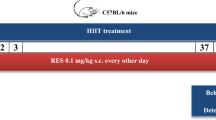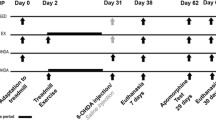Abstract
Parkinson’s disease (PD) is a neurodegenerative disease characterized by progressive and loss of dopaminergic neurons in the SNpc. Behavioral symptoms and cognitive impairments even dementia are common in Parkinson disease. Physical activity impacts functional recovery in humans, however, its effects in experimental animals submitted to Parkinson model have been inconsistent. The present work was focused on the neuroprotective effect of 4 weeks voluntary exercise (wheel running) against experimentally (6-OHDA) induced Parkinson’s disease in rat, by analyzing the memory and learning. Morris water maze test was used for measurement of spatial learning and memory. Results did not demonstrate any main effect differences between the exercise and control groups on weight gain (p > 0.05). 6-OHDA injection caused a significant cognitive deficit in spatial water maze tasks and this effect was reversed in rats after receiving exercise protocol. Voluntary exercise improved the cognitive performance in both reference and working spatial memory against 6-OHDA administration (p < 0.05). We suggest that voluntary exercise interventions may has the potential role in promoting neuroplasticity and repair cognitive dysfunction in Parkinson’s disease (PD).






Similar content being viewed by others
References
Miyasaki JM et al (2006) Practice Parameter: Evaluation and treatment of depression, psychosis, and dementia in Parkinson disease (an evidence-based review): report of the Quality Standards Subcommittee of the American Academy of Neurology. Neurology 66(7):996–1002
De Rijk Md et al (1997) Prevalence of parkinsonism and Parkinson’s disease in Europe: the EUROPARKINSON Collaborative Study. European Community Concerted Action on the Epidemiology of Parkinson’s disease. J Neurol Neurosurg Psychiatry 62(1):10–15
Fahn S (2003) Description of Parkinson’s disease as a clinical syndrome. Ann N Y Acad Sci 991(1):1–14
Sethi KD (2002) Clinical aspects of Parkinson disease. Curr Opin Neurol 15:457–460
Carbon M, Marié RM (2003) Functional imaging of cognition in Parkinson’s disease. Curr Opin Neurol 16(4):475–480
Witt K, Nuhsman A, Deuschl G (2002) Dissociation of habit-learning in Parkinson’s and cerebellar disease. J Cogn Neurosci 14(3):493–499
Lewis SJ, Slabosz A, Robbins TW, Barker RA, Owen AM (2005) Dopaminergic basis for deficits in working memory but not attentional set-shifting in Parkinson’s disease. Neuropsychologia 43(6):823–832
Ang ET, Gomez-Pinilla F (2007) Potential therapeutic effects of exercise to the brain. Curr Med Chem 14:2564–2571
van Praag H, Christie BR, Sejnowski TJ, Gage FH (1999) Running enhances neurogenesis, learning, and long-term potentiation in mice. Proc Natl Acad Sci USA 96:13427–13431
Tillerson JL, Caudle WM, Reveron ME, Miller GW (2003) Exercise induces behavioral recovery and attenuates neurochemical deficits in rodent models of Parkinson’s disease. Neuroscience 119:899–911
Petzinger GM et al (2013) Exercise-enhanced neuroplasticity targeting motor and cognitive circuitry in Parkinson’s disease. Lancet Neurol 12(7):716–726
Goodwin VA, Richards SH, Taylor RS, Taylor AH, Campbell JL (2008) The effectiveness of exercise interventions for people with Parkinson’s disease: a systematic review and meta-analysis. Mov Disord 23:631–640
Julien C et al (2006) Postmortem brain fatty acid profile of levodopa-treated Parkinson disease patients and parkinsonian monkeys. Neurochem Int 48(5):404–414
Samadi P et al (2006) Docosahexaenoic acid reduces levodopa-induced dyskinesias in 1-methyl-4-phenyl-1,2,3,6-tetrahydropyridine monkeys. Ann Neurol 59(2):282–288
Schapira AH et al (2006) Novel pharmacological targets for the treatment of Parkinson’s disease. Nat Rev Drug Discov 5(10):845–854
Kim D-H et al (2010) Treadmill exercise inhibits traumatic brain injury-induced hippocampal apoptosis. Physiol Behav 101(5):660–665
Kim S-E et al (2010) Treadmill exercise prevents aging-induced failure of memory through an increase in neurogenesis and suppression of apoptosis in rat hippocampus. Exp Gerontol 45(5):357–365
Bove J, Perier C (2012) Neurotoxin-based models of Parkinson’s disease. Neuroscience 211:51–76
Farbood Y et al (2015) Ellagic acid protects the brain against 6-hydroxydopamine induced neuroinflammation in a rat model of Parkinson’s disease. Basic Clin Neurosci 6(2):83–90
Rafie F, Shabazi M, Sheikh M, Naghdi N, Sheibani V (2017) Effects of voluntary exercise on motor function in Parkinson’s disease model of rats. Ann Appl Sport Sci 5(2):81–86
Da Cunha C, Angelucci ME, Canteras NS, Wonnacott S, Takahashi RN (2002) The lesion of the rat substantia nigra pars compacta dopaminergic neurons as a model for Parkinson’s disease memory disabilities. Cell Mol Neurobiol 22(3):227–237
Salari M, Sheibani V, Saadati H, Pourrahimi A, Esmaeelpour K, Khodamoradi M (2015) The compensatory effect of regular exercise on long-term memory impairment in sleep deprived female rats. Behav Process 119:50–57
Schrag A, Jahanshahi M, Quinn N (2000) What contributes to quality of life in patients with Parkinson’s disease? J Neurol Neurosurg Psychiatry 69(3):308–312
Gorton LM et al (2010) Exercise effects on motor and affective behavior and catecholamine neurochemistry in the MPTP-lesioned mouse. Behav Brain Res 213(2):253–262
Howells FM et al (2005) Stress reduces the neuroprotective effect of exercise in a rat model for Parkinson’s disease. Behav Brain Res 165(2):210–220
Nieuwboer A et al (2009) Motor learning in Parkinson’s disease: limitations and potential for rehabilitation. Parkinsonism Relat Disord 15:S53–S58 (48)
Sheibani V, Rafie F, Shahbazi M, Naghdi N, Sheikh M (2017) Comparison of voluntary and forced exercise effects on motor behavior in 6-hydroxydopamine-lesion rat model of Parkinson’s disease. Sport Sci Health 13(1):203–211
Hayes K et al (2008) Forced, not Voluntary exercise effectively induces neuroprotection in stroke. Acta Neuropathol 115:289–296
Kinni H et al (2011) Cerebral metabolism after forced or voluntary physical exercise. Brain Res 1388:48–55
Lambert M et al (1996) Tests of running performance do not predict subsequent spontaneous running in rats. Physiol Behav 60(1):171–176
Tarr BA et al (2004) Voluntary running distance is negatively correlated with striatal dopamine release in untrained rats. Behav Brain Res 154(2):493–499
Ferro MM, Bellissimo MI, Anselmo-Franci JA, Angellucci ME, Canteras NS, Da Cunha C (2005) Comparison of bilaterally 6-OHDA-and MPTP-lesioned rats as models of the early phase of Parkinson’s disease: histological, neurochemical, motor and memory alterations. J Neurosci Methods 148(1):78–87
Sconce MD, Churchill MJ, Greene RE, Meshul CK (2015) Intervention with exercise restores motor deficits but not nigrostriatal loss in a progressive MPTP mouse model of Parkinson’s disease. Neuroscience 299:156–174
Braak H, Rüb U, Steur EJ, Del Tredici K, De Vos RA (2005) Cognitive status correlates with neuropathologic stage in Parkinson disease. Neurology 64(8):1404–10
Murray DK, Sacheli MA, Eng JJ, Stoessl AJ (2014) The effects of exercise on cognition in Parkinson’s disease: a systematic review. Transl Neurodegen 3(1):1
García-Capdevila S, Portell-Cortés I, Torras-Garcia M, Coll-Andreu M, Costa-Miserachs D (2009) Effects of long-term voluntary exercise on learning and memory processes: dependency of the task and level of exercise. Behav Brain Res 202(2):162–170
Cotman CW, Engesser-Cesar C (2002) Exercise enhances and protects brain function. Exerc Sport Sci Rev 30(2):75–79
Crowley EK, Nolan YM, Sullivan AM (2018) Neuroprotective effects of voluntary running on cognitive dysfunction in an α-synuclein rat model of Parkinson’s disease. Neurobiol Aging 65:60–68
Paillard T, Rolland Y, de Souto Barreto P (2015) Protective effects of physical exercise in Alzheimer’s disease and Parkinson’s disease: a narrative review. J Clin Neurol 11(3):212–219
Alomari MA, Khabour OF, Alzoubi KH, Alzubi MA (2016) Combining restricted diet with forced or voluntary exercises improves hippocampal BDNF and cognitive function in rats. Int J Neurosci 126(4):366–373
Vučcković MG, Li Q, Fisher B, Nacca A et al (2010) Exercise elevates dopamine D2 receptor in a mouse model of Parkinson’s disease: in vivo imaging with (18F) fallypride. Mov Disord 25(16):2777–2784
Mabandla M, Kellaway L, Gibson ASC, Russell VA (2004) Voluntary running provides neuroprotection in rats after 6-hydroxydopamine injection into the medial forebrain bundle. Metab Brain Dis 19(1–2):43–50
Aguiar AS, Castro AA, Moreira EL, Glaser V et al (2011) Short bouts of mild-intensity physical exercise improve spatial learning and memory in aging rats: involvement of hippocampal plasticity via AKT, CREB and BDNF signaling. Mech Ageing Dev 132(11):560–567
Zang J, Liu Y, Li W, Xiao D, Zhang Y, Luo Y, Liang W, Liu F, Wei W (2017) Voluntary exercise increases adult hippocampal neurogenesis by increasing GSK-3β activity in mice. Neuroscience 354:122–135
Zhou W, Barkow JC, Freed CR (2017) Running wheel exercise reduces α-synuclein aggregation and improves motor and cognitive function in a transgenic mouse model of Parkinson’s disease. PloS One 12(12):e0190160
Acknowledgements
The authors thank the Neuroscience Research Center of Kerman, Iran for financial support; Dr. Khadije Esmaeilpoue and Dr. Sina Kakoei for their technical assistance in this project.
Author information
Authors and Affiliations
Corresponding author
Ethics declarations
Conflict of interest
The authors declare no conflict of interest.
Ethical approval
All experiments were performed in accordance with the National Institutes of Health ‘Guide for the Care and Use of Laboratory Animals’ and approved by the Ethics Committee of Kerman Neuroscience Research Center.
Informed consent
For this type of study the formal informed consent is not requried.
Additional information
Publisher’s Note
Springer Nature remains neutral with regard to jurisdictional claims in published maps and institutional affiliations.
Rights and permissions
About this article
Cite this article
Rafie, F., Sheibani, V., Shahbazi, M. et al. The effects of voluntary exercise on learning and memory deficit in Parkinson’s disease model of rats. Sport Sci Health 15, 399–405 (2019). https://doi.org/10.1007/s11332-019-00531-7
Received:
Accepted:
Published:
Issue Date:
DOI: https://doi.org/10.1007/s11332-019-00531-7




